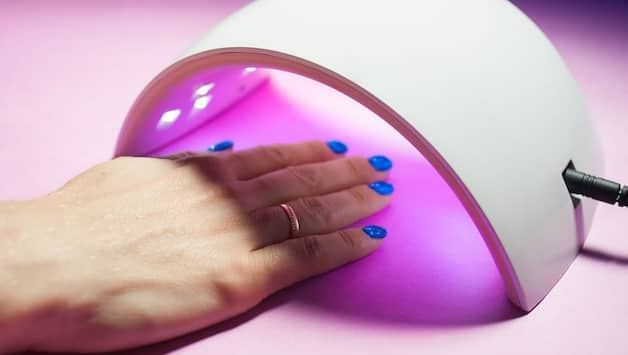A study from the USA is currently causing a stir. UV rays, which are used to harden gel nails during a manicure, could pose a potential cancer risk, the researchers said. What is known, what limitations there are and what those affected need to know. A check.
A rare form of skin cancer on a young woman’s finger made Ludmil Alexandrov suspicious. “I thought it was strange,” recalls the University of California San Diego professor of bioengineering, cellular and molecular medicine. In his research, he then came across several cases of people suffering from very rare types of cancer in the hands in specialist medical magazines.
The connection: They all wore gel nails frequently, including beauticians and women who often took part in beauty pageants. Alexandrov decided to scientifically investigate a possible connection.
Unlike regular nail polish or acrylic polish, which air dry, the fingernails are coated with a gel coat and then held under a UVA device. They look like little sunbeds for your hands. The gel hardens as a result of the irradiation.
In total, the process is repeated about three to five times and the nails are each held under the UV light for 60 seconds (may vary slightly). In total, the fingers are exposed to UV light for at least three to five minutes. The manicure usually lasts two to four weeks. Then the procedure starts all over again.
For the study, which was published in the journal Nature on January 17, Alexandrov, together with researchers from the University of California San Diego and the University of Pittsburgh, exposed human skin cells and mouse cells twice for 20 minutes (with a one-hour break) under a UV nailing device placed. As a result, about 20 to 30 percent of the cells died. In a second experiment – with a 20-minute irradiation on three consecutive days – even up to 70 percent of the cells died.
Of particular concern, the cells that remained after the full exposure period showed evidence of DNA damage and mutations associated with skin cancer. “We looked at samples from patients with skin cancer and saw the same mutation pattern as in the irradiated cells,” says study author Alexandrov.
However: As described above, people usually hold their fingers under a UV device for a much shorter time during a manicure. So the exposure in this study is comparatively extreme. Human cells were also examined, but not people who have several layers of skin and therefore better UV protection.
Conclusion: The study alone is not direct evidence of an increased risk of cancer. This is also what study author Alexandrov says. However, it indicates that a relevant risk could exist. The point at which exposure becomes dangerous has not yet been clarified and must now be investigated further. Alexandrov advocates a large-scale epidemiological study to quantify cancer risk in the general population.
The study caused a stir online: “That’s it, never more gel nails,” comments a user on Twitter. However, others also write: “And what isn’t carcinogenic these days?!”
In principle, UV-A light is classified as carcinogenic, according to the website of the German Cancer Research Center. However, this depends on the duration and strength of the radiation. The shorter the exposure time, the lower the skin damage.
There is a controversial debate as to whether and how harmful UVA light actually is – and sometimes contradicting studies. In practice, however, the experts agree that precautionary measures should be taken. Susanne Weg-Remers, Head of the Cancer Information Service, recommends: “Anyone who does not want to do without modeled nails should take UV protection measures when visiting the nail salon in order to keep the risk as low as possible. Use sun block or sunscreen with a high SPF. Fingerless gloves also provide protection.”
There are now also alternatives: some gel nail polish can also be cured with LED light. As a rule, these are without UV radiation, but not always. It is advisable to ask at the nail salon. There is now also a new dip technique in which the gel nails are dipped in powder and do not have to be under a UV light.
